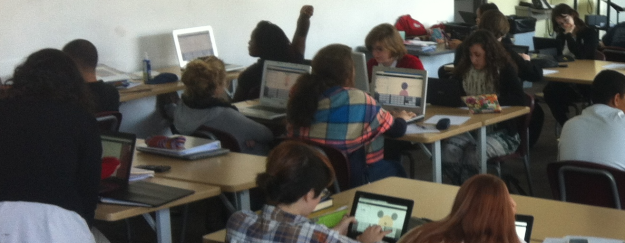I love Desmos. I love how user-friendly and clean the whole thing is. I want my students to love it too, so I used the first lesson back after midterms to let them play.
The Aim
For my students to get a feel for the shape of various functions and relations through using Desmos to create a piece of art. (CC Standard F.BF.3)
The activity
- Students take a look at http://www.desmos.com/art to see what is possible just by typing in equations (Great hook)
- I explain to students that they have this lesson and a homework to come up with a piece of art of their own using desmos.com/calculator.
- I have a sheet ready with some example functions (linear, quadratic, circular relations, radical and rational) for them to use if they are struggling. I also introduce the idea of sliders for them to use.
- They have around 50 minutes plus a homework to come up with a piece of art of their own.
Some of the resultant artwork
What went well
- Any lesson where students are crying out for the Math is a good thing. It was amazing to be asked how to draw a smiley face using a parabola and domain and range and how to draw circles and ellipses. I had one student ask how to do a ‘diagonal porabola!’ I had to look that one up.
- Students were constantly engaged. Sometimes frustrations got the better of them and they needed some encouragement to keep going but generally, the lesson went really fast.
- It was great for all abilities. Students that normally struggle got the chance to play around with linear and quadratic functions, helping them to understand what changing the numbers did to the graph.
Even better if
- This was too early in the year to do this lesson. I would like to do this next time at the end of the year when students had more functions and tools at their finger tips. I did like how it cemented the need for domain and range, though.
- This lesson is leading into our quadratics unit. Going back I would have really liked to focus far more on parabolas so that our next lesson on Vertex Form would make sense from the start. I still think it will help, I just think I may have missed an opportunity to go deep rather than broad.
- This lesson relies heavily on technology. Being a Bring-Your-Own-Device school, some students had tablets that were very tricky to use (this also happened with Khan Academy). I may have to rethink how I do this and use it possibly for homework.
Student Reaction
Here are results from a mini survey I did at the end of each class
Students also said:
This activity allowed me to visualize what adding variables does to the shape of an equation.
I loved the creativity involved with it, but also the brain work involved when trying to make different shapes and move them around.
Technical difficulties were frustrating, but I realize this is something that is hard to fix.




